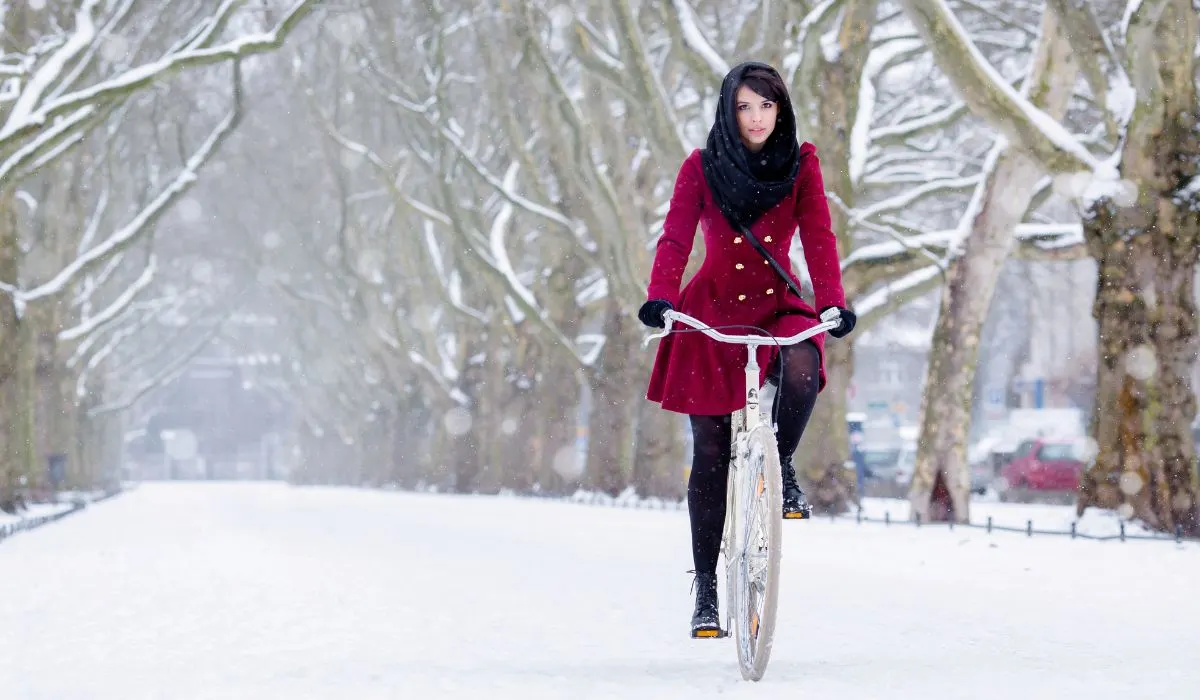
Riding a bike to work can be a great way to get exercise and reduce your environmental impact. During the spring and autumn months, this is a great experience. However, during the winter it can be a different story.
The spirit of any cyclist can be tested by freezing:
- wind
- snow
- ice
But with a few simple tips, you’ll be able to get riding to work easily and simply. Here is what you need to know.
Keep Riding
With winter’s cold weather freezing cyclists, it can be tempting to stop and wait until it warms up again. However, there is a better approach to take. There are plenty of reasons why you might want to keep riding during the winter months.
One of the biggest reasons is to stay healthy. Cycling works out all the major parts of the body. This can help you lose weight and build muscle.
Often, riding during the winter months will be a tougher workout than during summer. There will be more obstacles for you to overcome. For example, you might need to ride through thick snow, which will build endurance and strength.
There are a few other benefits too. Many people take public transport and cars to work to get out of the cold. By riding your bike, you’ll be able to avoid overcrowded buses and traffic jams, and get to work on time.
Riding to work might be able to improve your work performance. Riding in the cold snow will force you to be more alert to keep an eye out for ice on the road. When you arrive at work, you’ll be more focused. Physical exercise will also help the blood start pumping, keeping you mentally active.
Wear Warm Clothes
When riding in winter, there are a lot of environmental conditions to contend with. There will be cold wind and you might need to ride through ice and snow. The clothes that you wear will play a crucial role and are responsible for protecting you from the elements.
The key to staying warm is to wear layers. You’ll want to start with a good base layer (here’s a great one on Amazon). This will allow you to add or remove clothes, to keep you warm throughout the ride.
There are different types of base layers for you to try. On milder days, you can opt for a short-sleeved option like this one sold on Amazon. However, on colder days, you’ll want a long-sleeved option, like the one I mentioned above.
After the base layer is complete, a jacket or a vest, (both Amazon links), is essential to protect you from the wind. They can also keep you dry when it’s snowing. After you’ve been riding for a while, you’ll be able to take these off. Since they are so light, they won’t take up much space in your backpack.
Gloves protect your hands from the cold wind. Choose cycling gloves that are light enough to wear comfortably that will also help keep a tight grip on the bike handles, like these ones from Amazon.
Arm warmers, like these on Amazon, are a great way to provide protection for your arms. If they ever get too hot, you’ll be able to easily remove them.
Don’t forget to take care of your head since it’s where we lose most of our heat! A simple cap or beanie, like this one on Amazon, will be enough to keep your head warm. As always, you’ll want to make sure that you are wearing a helmet.
Some like to wear protection for their eyes. Goggles like these (Amazon link) will help stop any snow or ice from getting in them.
Finally, waterproof your feet. Thicker socks seem like they would provide extra warmth, but in reality, they trap moisture and make feet feel damp. Instead, you’ll want to wear some booties over your riding boots, like these (Amazon link), to stop snow and ice from penetrating them.
How Warm Should You Be?
You don’t need to wear winter riding gear all at once. Instead, you’ll want to think about how you feel before you start riding. While you don’t want to be freezing, you do want to be a little chilly.
When you start cycling you’ll warm up, so pick layers that are easy to remove and store.
Insulate Your Liquids
Cold weather can make storing liquids very difficult. If you’re not careful, they will freeze and be unusable during your ride. Riding through the snow can take an intense physical toll, and there is a risk that you will get dehydrated on your journey.
The solution to this problem is to insulate your liquids. These bottles sold on Amazon, are designed to retain heat so drinks won’t freeze, even when subjected to freezing temperatures. This will allow you to stop along the way and have a refreshing warm drink.
Prepare Your Bike For Winter Conditions
One of the biggest mistakes that people make is assuming that their bike won’t be able to operate in the winter months. This isn’t true. Most bikes require a few minor adjustments to be able to tackle snowy conditions.
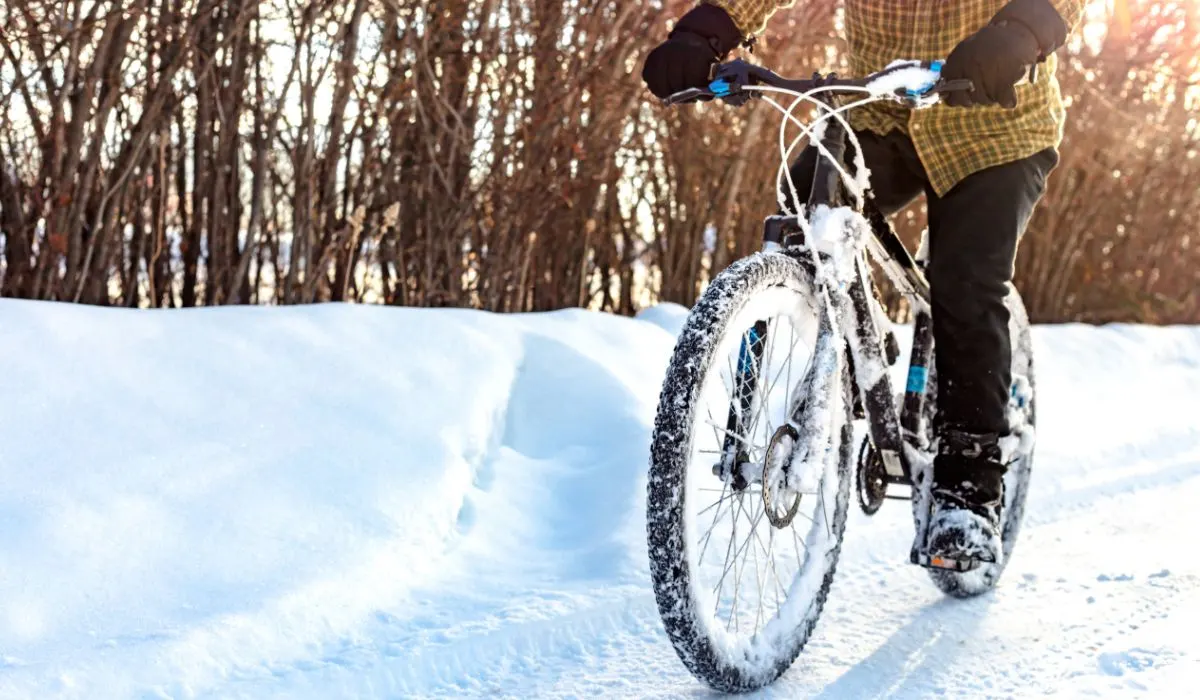
Let’s look at some simple things that you’ll need to do to prepare.
Add Fenders
First, add some fenders. When you’re riding to work in the spring and summer, fenders will protect you from mud and dirt. During the winter months, they play a more important role: to stop you from getting covered with ice and snow. No one wants to show up at the office covered with slush.
In some cases, a bike will come with fenders, and in other cases, it won’t. Thankfully, most modern bikes will come with the option of adding fenders later.
There should be slots for you to attach the fenders to, you just need to make sure to pick ones that are the right size. It’s a good idea to check the owner’s manual before you buy.
Use Fat Tires
The best way to prepare for riding in the snow is by using fatter tires. This will spread your weight out over a larger surface area, and help you get over any bumps in the road.
If you don’t have fat tires, you can try reducing the PSI in your existing tires. It’s best to experiment with the PSI before winter to help ensure that you don’t end up accidentally puncturing your tire.
If your local area gets a thick layer of snow, use tires that are modified to give you more traction and prevent sliding. First, try placing a chain around your tires.
You can also get tires that have snow spikes. Though they can be more expensive, it will be worth it to keep you safe while riding in the snow.
Add Lights
The winter days are darker than summer or spring. Add some more lights to your bike so that cars will be able to see you. This is a simple step that can stop accidents from occurring.
A light that is battery-powered light is a good option. When you’re shopping, you want to look at the number of lumens it can generate. The higher the number of lumens, the brighter it will be.
It’s also a good idea to think about light reflective clothing to give you extra certainty that cars will be able to see you.
Depending on what time you leave work, consider adding headlights. You should be able to find a powerful one to attach to the frame of the bike.
You might also want to put a headlamp, (here’s a great one on Amazon), into your saddlebag for performing repairs. You’ll be able to see clearly in dark weather while leaving your hands free to make the changes.
Carry a Puncture Kit
When you’re riding in winter conditions, there will be more hazards that can puncture your tires buried in the snow, like:
- sharp ice
- rocks
- sharp sticks
To be prepared, make sure that you have a puncture kit (Amazon link), in your saddlebag.
In this kit, you’ll need to think about what type of pump you want to use. Many people like CO2 pumps because of how quick they are, but in cold temperatures, the gas might freeze. It’s best to pick another type of pump, at least until things warm up.
It’s also important to make sure that you carry a phone on you. If something does go wrong, you’ll be able to contact a colleague and arrange for them to pick you up.
Try a Dirt Bike
In summer, a road bike might be one of the best commuting options. However, during the winter, the roads can be more difficult to navigate.
Try switching to a dirt bike or a mountain bike for the winter season. These bike types can give you a little more control and better handle any rough patterns.
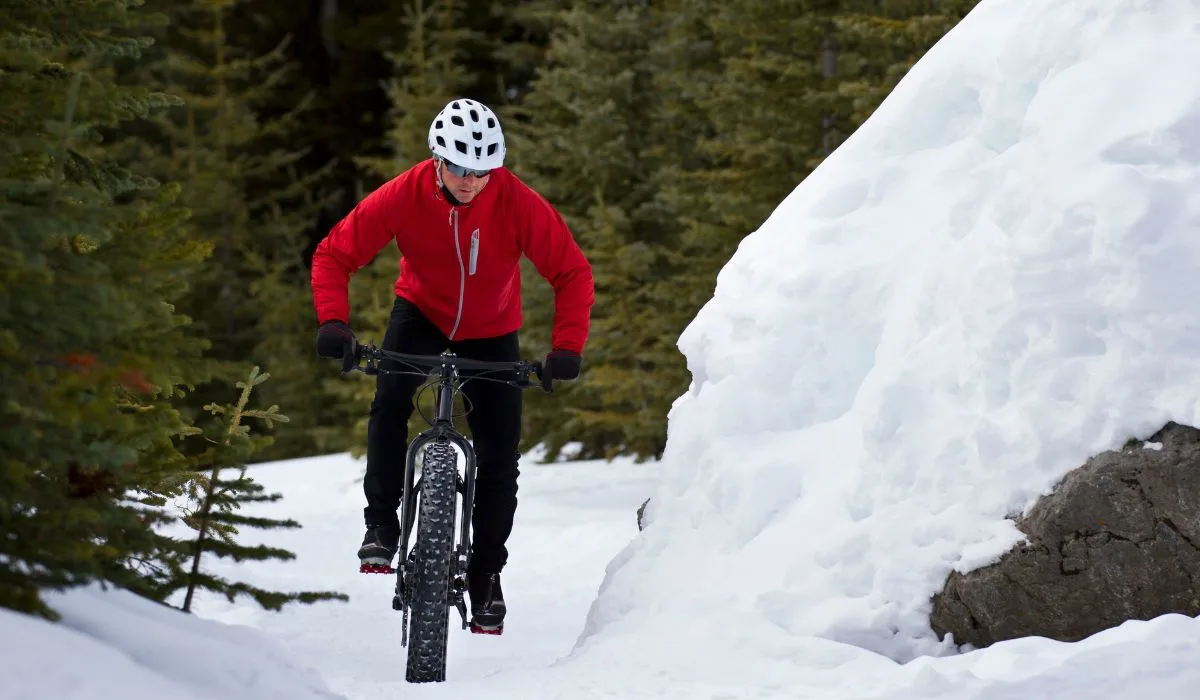
Maintain Your Bike Regularly
Cycling during the winter can bring a new series of challenges. One of the biggest is the need to maintain your bike more regularly. When you cycle in the snow, your wheels kick up a lot of sludge. Often, this will be very salty.
If this sludge stays on your bike for a long time, your bike can develop rust which can be a big problem. It might shorten the lifespan of your bike. It can also mean that you’ll need to replace the chain more frequently. The best solution is to wash your bike off after every ride.
You’ll also need to spend more time lubricating the bike components. It’s best to use a thicker lubricant, which is more difficult to be removed from the silt.
If you notice that there is some ice built up on the tires, you might want to use some WD40. While this is normally a bad idea, it can be a good solution to grime build-up during the winter.
While you’re doing this, check what condition the bike is in. Sometimes, grit and sludge can build up on the brakes and the rim. It’s also possible that the brake cable might have started to fray. Make sure that there isn’t anything stuck into the tire.
Though it only takes a few minutes, you’ll be able to spot issues early and change the components before they break on a ride.
Pick a More Sheltered Route
One of the biggest problems of riding in the cold is the wind chill which can make the day feel a lot colder than it really is. Though you might be wearing a jacket, the wind chill can still cut through the fabric making you feel cold.
One solution is to try a more sheltered route to work. Look for structures that can help block the wind, like trees or buildings.
When picking your route, think about what condition the roads will be in. If there is ice forming along the road, it can be very dangerous. In this case, there will be a limited amount of traction. If this is on a downhill section of the road, it can be very difficult to stop in time.
Stay Calm
One of the most concerning parts of cycling in the winter is that your bike can hit icy patches. Even if you have chains or spikes on your tires, there’s still a risk that you will lose control.
When this happens, it can be a major concern. The key to getting out of this situation safely is knowing how to control your bike.
Avoid oversteering which can make a slide even worse, taking the bike into a dangerous situation. Instead:
- stay calm
- loosen everything
- focus on smaller movements
This will often take a bit of practice before you can master it.
Ride to the Conditions
Besides ice, there are plenty of other potential concerns that you could face. Each of these will require you to change the way that you ride, to make sure that you are safe.
For example, winter can sometimes cause fog to form over the roads, which can be a very dangerous time with reduced visibility.
Combined with a snowy road, important signs could be missed, like a rock in the path. If possible, avoid riding over puddles. It can be difficult to know how deep the hole is or what might lie at the bottom.
It’s essential to travel a little slower during the winter months. The conditions will usually mean that it’s not safe to travel fast. Leave a longer buffer time to ensure that don’t have to stress if something goes wrong on your way to work.
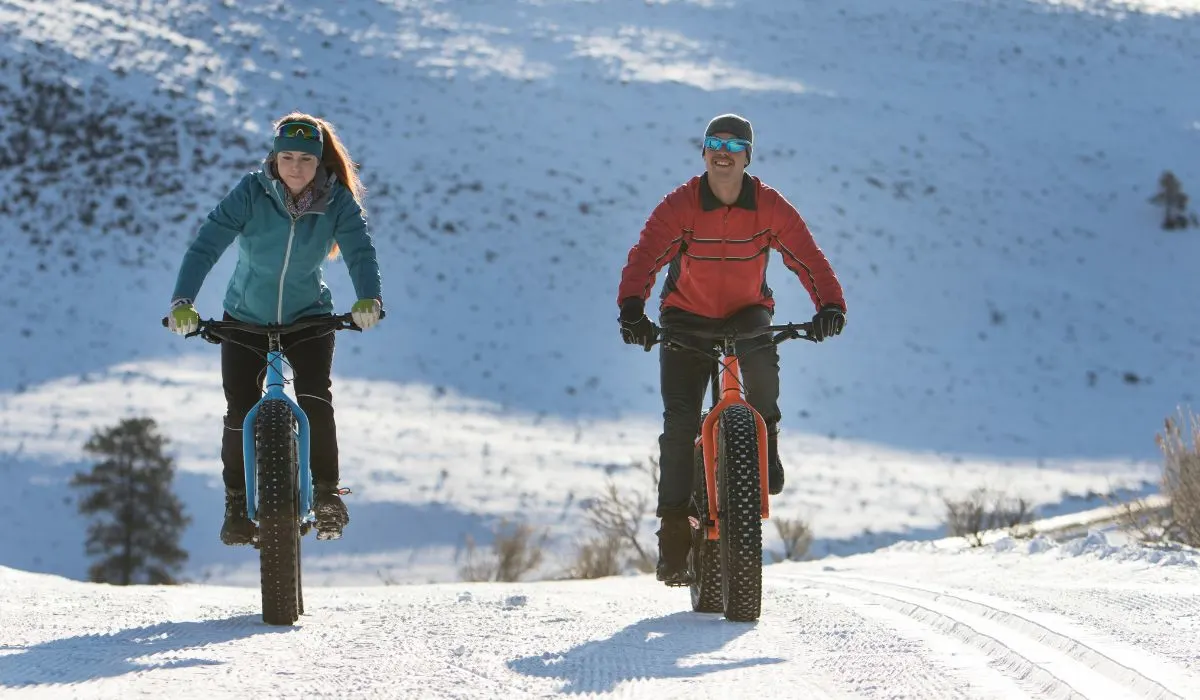
Ride With a Group
Winter is the perfect time to start riding with a group. There are a few reasons why this can be a good idea.
- There is safety in numbers. A large group of riders will be more noticeable than a single cyclist.
- If one of you develops a problem, the whole group will be able to help solve it.
- If you don’t have the right equipment, surely someone else in the group will.
- During the ride, you’ll be able to support each other. This can be a good motivation to get up in the morning.
- If riding with workmates, you’ll be able to form a closer connection.
How Cold is Too Cold to Ride a Bike?
If you’re asking if it is okay to ride a bicycle to work during winter, you’re likely concerned about how cold it gets. There are some days when the conditions can be too cold. At these times, it might not be a good idea to ride to work.
Here are some of the things to consider:
#1: Air Temperature
Many people automatically turn to the air temperature. While this is important, it shouldn’t decide whether or not you ride. When you breathe in cold air, it gets warmed up in the nostrils.
The only time when you might need to consider air temperature is if you have a breathing condition like asthma. If this is the case, you might need to start slower. It can be a good idea to do some breathing exercises to get your body ready to process colder air.
#2: Rain and Snow
The more important factor to consider is whether or not it is raining or snowing. If you get wet, you will lose heat faster. This, combined with a significant wind chill, could make you hypothermic.
This is especially important for those who have a long distance to travel to work. Get into the habit of checking the weather forecast before you leave. While it might look like a peaceful day, the weather can turn quickly, bringing strong winds and snow.
The best way to decide whether or not it’s safe to ride is to use a wind chill chart to calculate the temperature and the wind, to get the wind chill factor. It also tells you what times it will be too dangerous to consider cycling.
I like to use this chart from the National Weather Service.
#3: Exercise Alternatives
Even though the conditions might stop you from riding outside, you can still exercise. You can set your bike on a stand inside and track how many miles you are riding each day.
Start Riding
Often, the biggest problem that you will face is psychological. Seeing the snow and feeling the wind on your skin can make the prospect of riding unappealing.
Even once you have winter gear on, you’ll still feel cold. At these times, you’ll just need to start riding, you’ll soon start to warm up. The most important thing is to get started.
At the start of winter, getting out onto your bike can be a major challenge. The best way to get over this is by building a strong routine to get used to heading out to your bike and riding at the same time each day. Once you’ve formed this habit, it will be easier to brave the cold weather.
It’s also a good idea to prepare the night before with this checklist:
- make sure the bike is in good condition
- lay out all the equipment that you’ll need
- check that the light is working
- get the latest weather report
- double-check that you know the route you’ll be taking
By doing this the night before, all you need to do in the morning is get on your bike and start riding.
Training in the Winter
For some people, riding into the office is a great way to stay physically fit. For others, it’s so that they can train for an upcoming event. If this is the case, you shouldn’t abandon your training just because it’s getting cold. In fact, winter is the ideal time to push yourself even harder.
Training in winter will usually be different than it will be in the summer months and is a good chance to improve your weakest aspects before competition season.
If you spent the summer competing, you’ll likely have good core fitness, making winter an ideal time to try to improve your top speed. You can apply these concepts to a daily commute.
The best way to do this is by doing a tempo ride, which means that you’ll be pushing yourself to ride harder for a longer period. Set a top speed, then try to maintain it for as long as you can. In competitions, this will train you to travel faster during difficult parts of the course.
If you struggled with your endurance during the summer, winter is the ideal time to work on this aspect. This will often mean that you’re taking on a longer ride to focus on intensity, rather than speed. A power meter will be able to help you monitor this.
If you are planning on training, make sure that you’re building in some time for recovery. This will ensure that you don’t end up burning out. During this time, limit the intensity of the training.
If you are riding to work, try the most direct route. It can even be a good idea to drive to work for a few days. Aim for a recovery week every month. A coach might be able to help you come up with an effective routine.
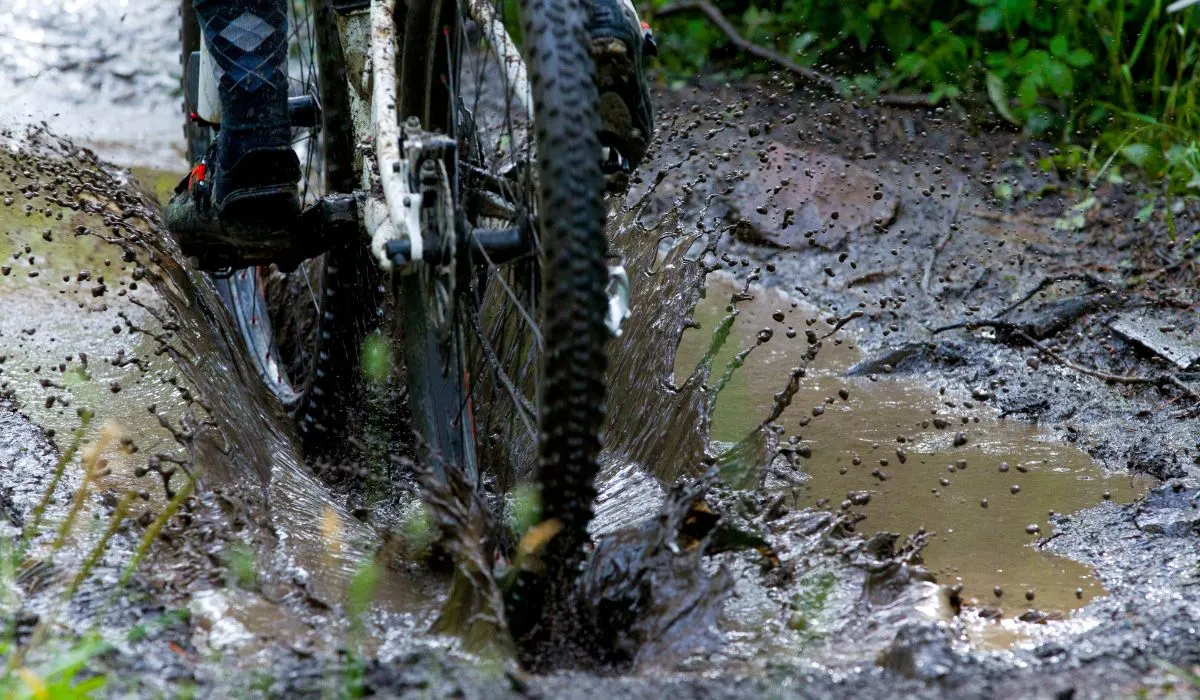
Final Thoughts
Winter can be an intense period making the prospect of riding to work unappealing with:
- snow
- ice
- freezing wind
But this doesn’t need to be the case. There are plenty of things you can do to beat the cold.
- Layer up your clothing.
- Prepare your bike.
- Ride with a group.
By doing this, you should be able to ride to work in comfort during the winter months!
You might also be interested in:
